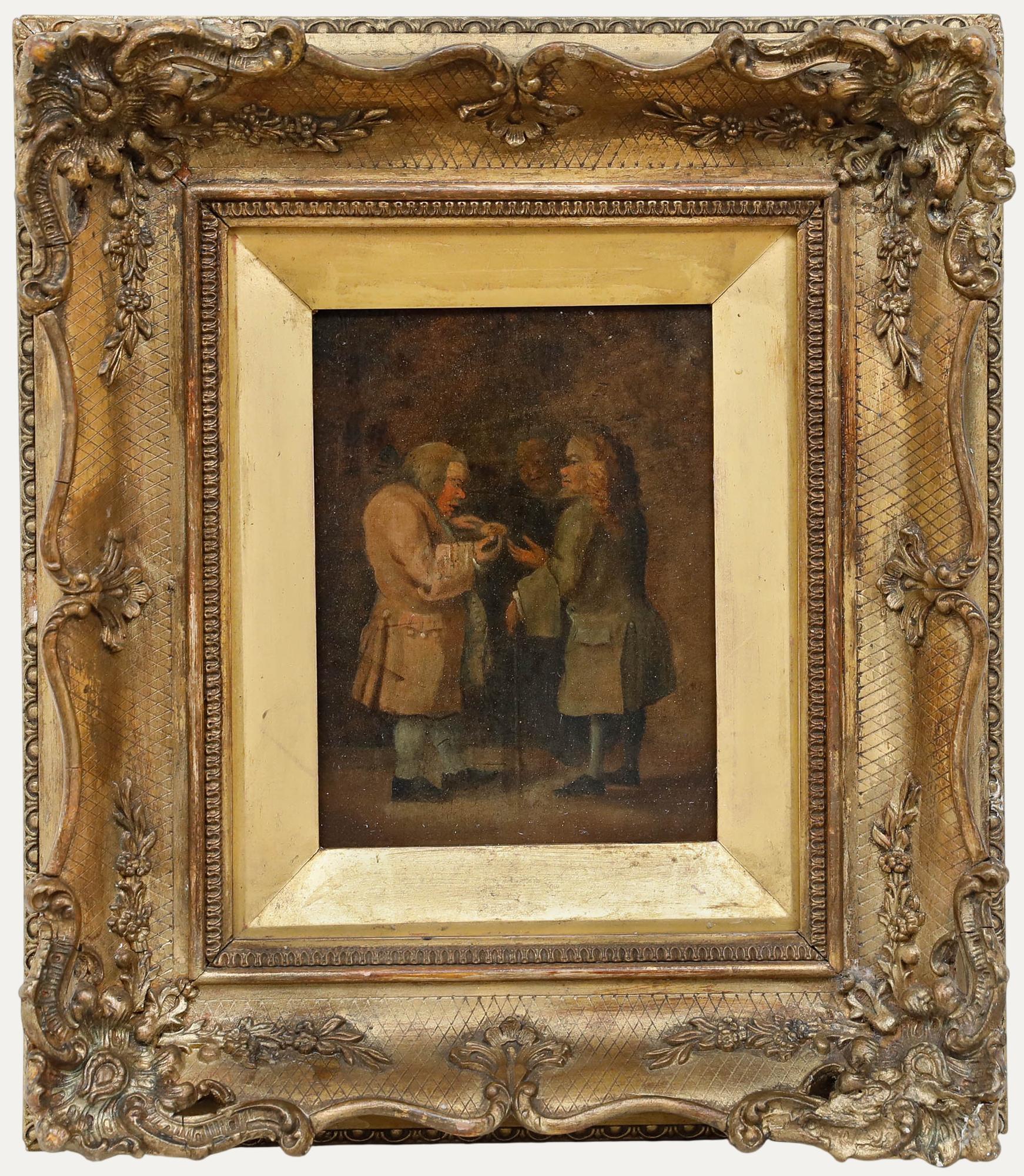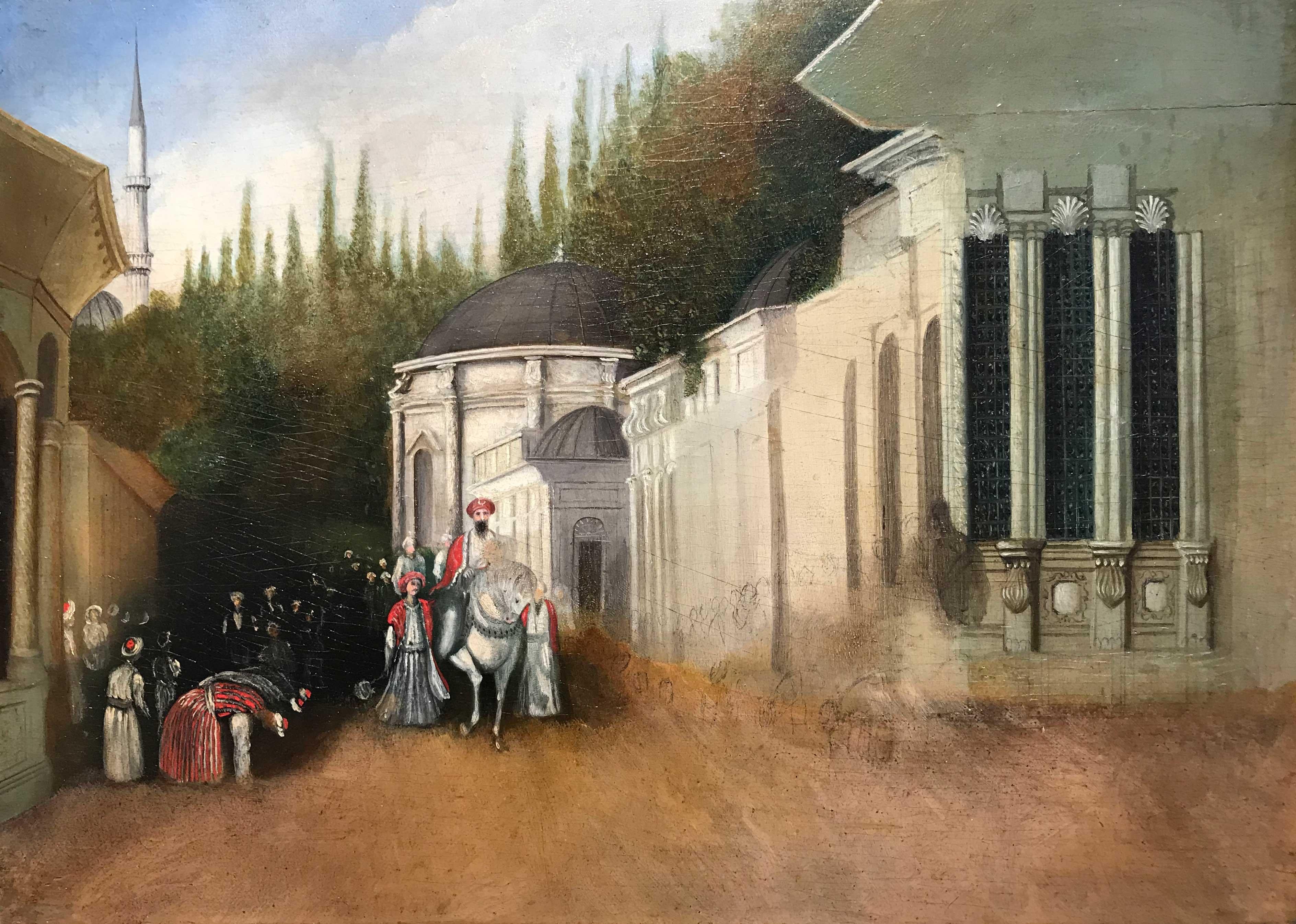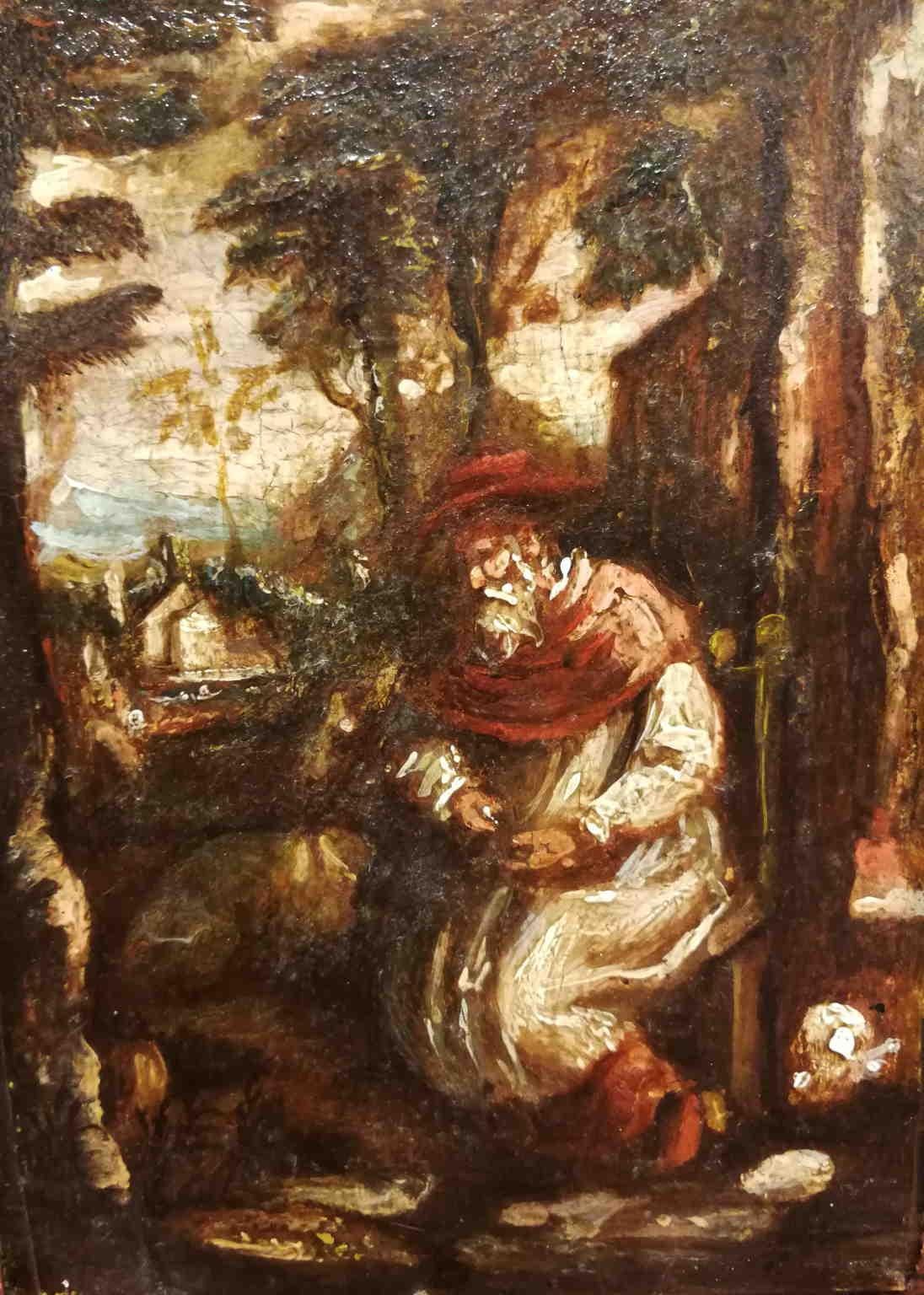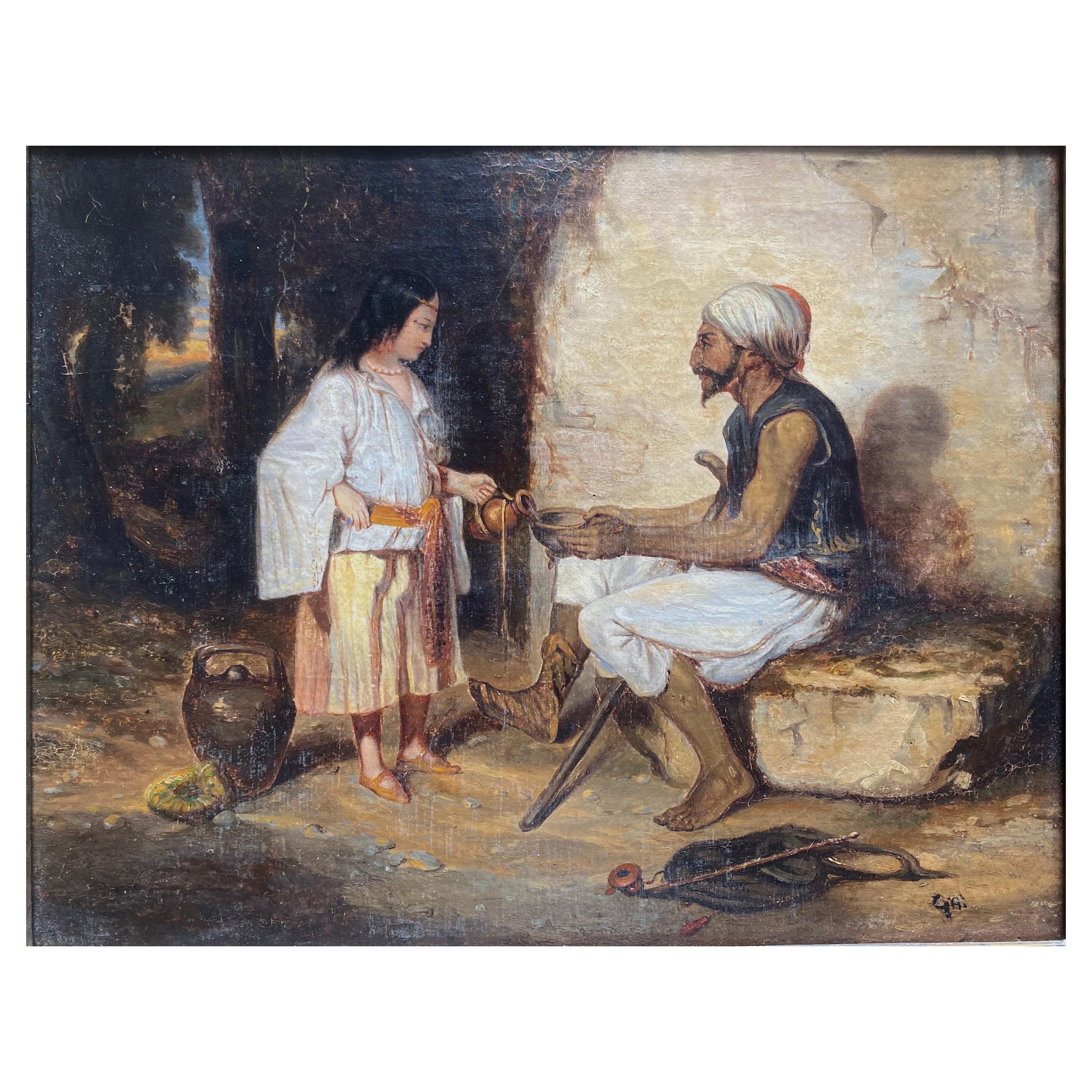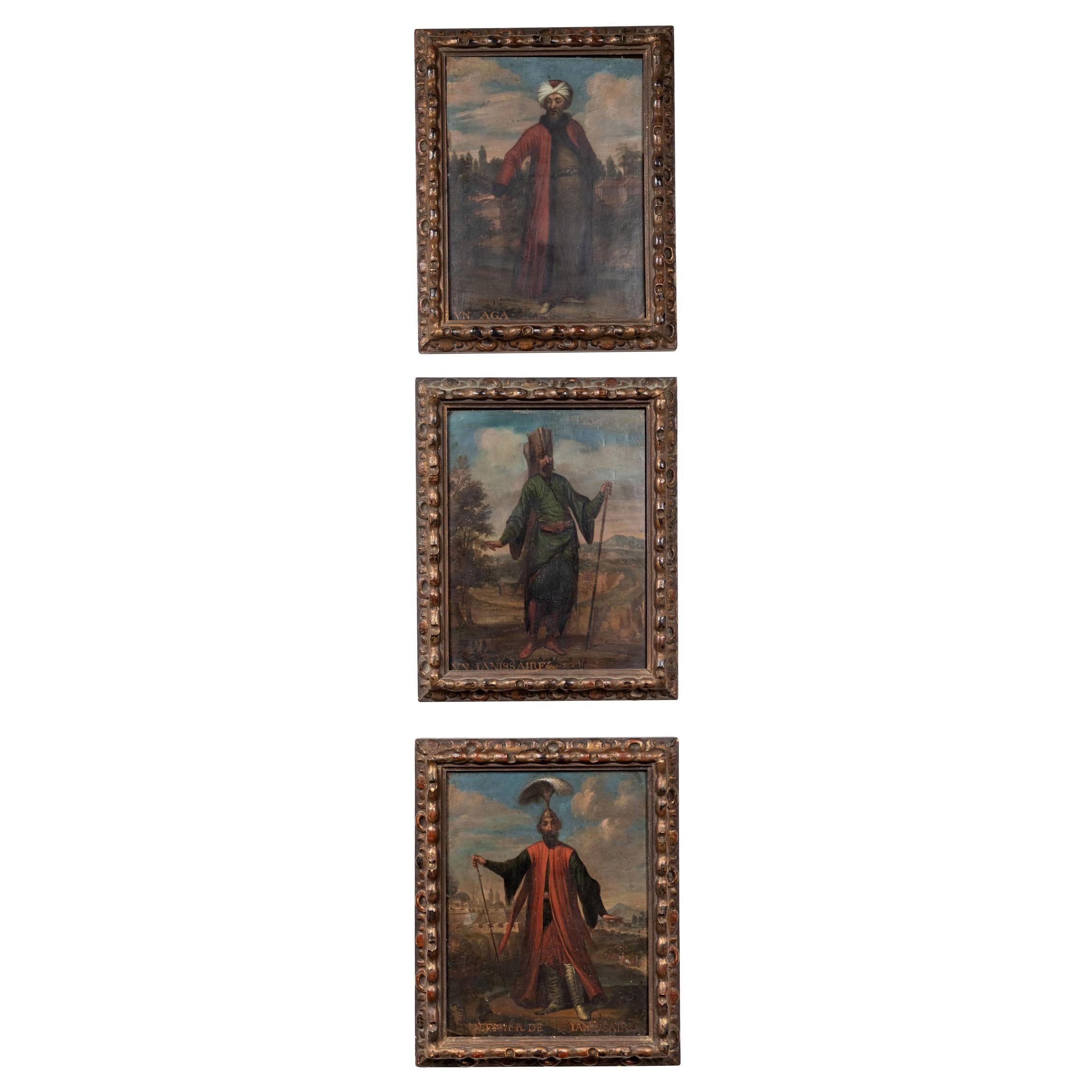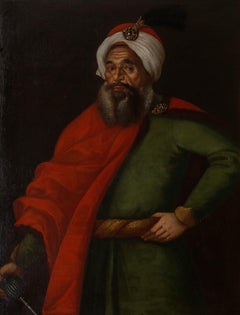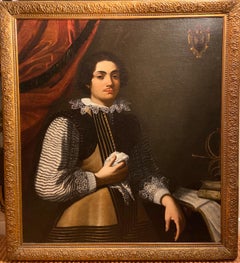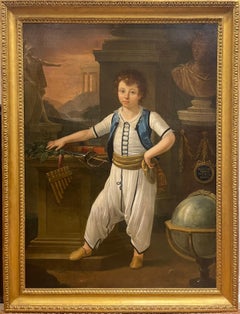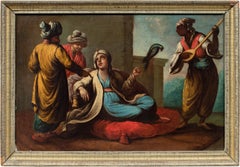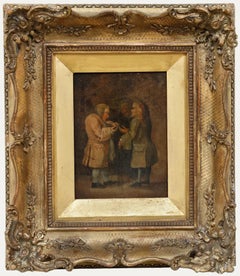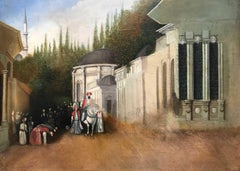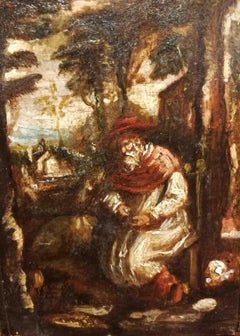Items Similar to Venetian School, Ottoman Honey Merchant
Want more images or videos?
Request additional images or videos from the seller
1 of 4
UnknownVenetian School, Ottoman Honey Merchantc. 1620
c. 1620
$217,153.82
$271,442.2820% Off
£160,000
£200,00020% Off
€186,795.93
€233,494.9220% Off
CA$304,113.07
CA$380,141.3420% Off
A$333,518.52
A$416,898.1520% Off
CHF 172,739.13
CHF 215,923.9220% Off
MX$4,007,486.91
MX$5,009,358.6420% Off
NOK 2,175,197.26
NOK 2,718,996.5720% Off
SEK 2,041,484.79
SEK 2,551,855.9920% Off
DKK 1,395,539.03
DKK 1,744,423.7920% Off
About the Item
This incredibly rare early depiction of an Eastern Mediterranean or North African honey merchant is thought have been painted circa 1620. It predates the Flemish-French painter Jean Baptiste Vanmour (1671-1737) by around 100 years. Vanmour has been considered, until the emergence of this painting, to be the earliest and most refined recorder of Ottoman secular life.
In the present painting, the honey merchant sits in his carpeted tent in obvious control of the trade around him. His accountant sits in deference whilst the apiarists and their workers present their straw skeps, or hives. This fascinating scene of everyday life in the Ottoman world, an Empire which included the Eastern Mediterranean and North Africa, illustrates much more than at first glance. Such an early depiction executed in oil on canvas is exceptional. Aside from the two iconic painters Gentile Bellini (active about 1460; died 1507), with his portrait of the Sultan Mehmet II of 1480 in the National Gallery, London and the aforementioned Van Mour, there are scarce western depictions of Ottoman or North African existence.
The artist of Ottoman Honey Merchant was probably Venetian both on stylistic and cultural grounds. The artist seems to be aware of the Bassano family of artists, reflecting their same blocky figures. The book-keeper turned away from the viewer is also familiar stylistically to the Bassano dynasty. Certainly the strong and particular narrative content suggests the recording of a first-hand experience, although the potential name of this itinerant artist is not currently known.
Venetians were still the largest foreign community in Istanbul during the sixteenth century and remained the Ottomans’ most important international trading partners well into the seventeenth century. This mutually beneficial relationship provided each partner with access to key ports and valuable goods. Though territorial wars intermittently interrupted their relationship, both empires relied on trade for their economic well-being. As a Venetian ambassador expressed, ‘being merchants, we cannot live without them.’ The Ottomans sold wheat, spices, raw silk, cotton and ash (for glass making) to the Venetians, while Venice provided the Ottomans with finished goods such as soap, paper and textiles. The same ships that transported these everyday goods and raw materials also carried luxury objects such as carpets, inlaid metalwork, illustrated manuscripts and glass.
Honey was a highly significant commodity in Ottoman Empire during the period 1200 to 1700. It was produced in huge quantities in almost every non-arid coastal region, from the Black Sea all the way to modern day Morocco, although it was most abundantly harvested in Attica and Turkey. The honey was used as a sweetener but also as a preservative for fruits and fresh produce like meat, the wax from the bees was a pleasant-smelling core source of lighting and the honey could also be used medicinally as a natural antiseptic. Unsurprisingly, the Ottoman rulers had their own tax code for honey, with the duty collected being one akcËeor two akcËes from each beehive, depending on the locality and custom.
The painting is redolent with period detail: the merchant sits on a flat weave rug; in front of him is a painted tray (possibly either metal or papier maché) with a brass coffee pot and a white, glazed cup and saucer. He wears prayer beads on his wrist. The blue and white tent has been erected close to a town gateway which can bee seen beyond. The book-keeper wears what appears to be a black burnous with a white hood; this garment derives from the Berber Nomadic tribes and therefore strongly suggests that the scene could be identified as being North African. To the right are three black men, almost certainly enslaved (the middle of the three being heavily disguised in a dark hood). There was an ancient slave trade across the Sahara to the Mediterranean coast and also up the east coast of Africa and the Red Sea as there were restrictions on the enslavement of Muslims, “pagan” areas further to the south became an important source of enslaved people. Ottoman areas of Anatolia and Attica tended to enslave Christians from the Black Sea and the Balkans, often prisoners of war. Therefore, the existence of the three figures to the right emphasises the likely location of this picture as being North Africa.
A secular painting of such antiquity of any trade is profoundly rare. But the fact that the trade illustrated is the buying and selling of honey and beeswax is even more enthralling, it being one of the most universal and ancient of foods, sources of light and medicine. There is evidence of human harvesting of honey from over 8,000 years ago. And the honeybee itself has become a symbol of the natural health of the planet: bees are vital for the preservation of ecological balance and biodiversity in nature. They provide one of the most recognisable ecosystem services, that being pollination, which makes production of food possible. By doing so, bees protect and maintain ecosystems as well as animal and plant species, and contribute to genetic and biotic diversity. Bees also act as indicators of the state of the environment. Their presence, absence or quantity tells us when something is happening with the environment and when appropriate action is needed.
This painting is therefore a uniquely complex and layered object, addressing the history of art, trade, culture, race, dress, custom, food, and natural sciences.
About the Seller
5.0
Vetted Professional Seller
Every seller passes strict standards for authenticity and reliability
Established in 1990
1stDibs seller since 2017
42 sales on 1stDibs
Typical response time: 1 hour
- ShippingRetrieving quote...Shipping from: London, United Kingdom
- Return Policy
Authenticity Guarantee
In the unlikely event there’s an issue with an item’s authenticity, contact us within 1 year for a full refund. DetailsMoney-Back Guarantee
If your item is not as described, is damaged in transit, or does not arrive, contact us within 7 days for a full refund. Details24-Hour Cancellation
You have a 24-hour grace period in which to reconsider your purchase, with no questions asked.Vetted Professional Sellers
Our world-class sellers must adhere to strict standards for service and quality, maintaining the integrity of our listings.Price-Match Guarantee
If you find that a seller listed the same item for a lower price elsewhere, we’ll match it.Trusted Global Delivery
Our best-in-class carrier network provides specialized shipping options worldwide, including custom delivery.More From This Seller
View AllPortrait of Ochius, also called The Passia Ahmed ex Royal Collection of Hanover
By (Attributed to) Sir Godfrey Kneller
Located in London, GB
Attributed to Sir Godfrey Kneller (1646 - 1723)
A Portrait of Ochius, also called The Passia Ahmed
Oil on canvas
In a gilded frame
Painted circa 1689 following the siege of Belgrad...
Category
17th Century Portrait Paintings
Materials
Oil
$70,574 Sale Price
20% Off
Free Shipping
17th Century Italian Oil Painting Portrait of Music Prodigy Girolamo Frescobaldi
Located in London, GB
Portrait of Girolamo Frescobaldi (1583-1643)
Attributed to Antiveduto Della Grammatica (1571-1626)
Oil on Canvas
1605-1609
Framed in a Nineteenth Century gild and composite frame
44....
Category
Early 17th Century Baroque Figurative Paintings
Materials
Oil
A Full-Length Portrait of Nicholas I of Russia in a Classical Setting
Located in London, GB
A Full-Length Portrait of Nicholas I of Russia in a classical setting. Pietro Labruzzi (1739–1805). 1802.
Signed, located and dated lower left: ‘Pietro Labruzzi Roma Pinx Anno 1802.’
Oil on canvas.
Dimensions:
Unframed: 135.7 x 98.5 cm.; 53½ x 38¾ in.
Framed: 151.6 x 115.6 cm.; 59¾ x 45½ in.
Description:
Nicholas I (Russian: Nikolay Pavlovich) (1796-1855), Russian Emperor...
Category
Early 1800s Paintings
Materials
Canvas, Oil
A Portrait of a Gentleman, thought to be Moses Diego Lopez Pereira
Located in London, GB
Austrian School, 18th Century
A Portrait of a Gentleman, thought to be Moses Diego Lopez Pereira, 1st Baron d’Aguilar, in an elaborate coat and a powdered wig
Oil on canvas
Provena...
Category
18th Century Paintings
Materials
Canvas, Oil
Large Beautiful Early 17th Century Painting of St Peter
Located in London, GB
17th Century Italian School
St Peter
Oil on Canvas
55 1/2 x 41 inches
This large and tender rendering of Saint Peter was painted by the hand of great Italian painter of the 17th Cen...
Category
Early 17th Century Baroque Portrait Paintings
Materials
Oil
16th Century Italian Renaissance Old Master Portrait of a Procuratore
By Jacopo Bassano
Located in London, GB
Jacopo BASSANO (c. 1510-1592, Italian)
Portrait of a Procuratore
Oil on canvas
30 ¼ x 26 inches (including frame)
Provenance: Lucien Bonaparte’s Collection (as Portrait of Doge Priuli, Tiziano); Rich-mond, Virginia Museum, Portrait of Doge Lorenzo Priuli.
The painting is a portrait of a man half-length, on a black background. It is a three-quarter portrait, according to a custom very common in the genre of portraiture in sixteenth century. The man is wearing a decorated...
Category
16th Century Old Masters Portrait Paintings
Materials
Oil
$238,869 Sale Price
20% Off
Free Shipping
You May Also Like
Orientalist Venetian painting - 18th century figure painting - Turkish scene
Located in Varmo, IT
Venetian painter (18th century) - Turkish nobles with parrot and musician.
43.5 x 63.5 cm without frame, 50 x 70 cm with frame.
Antique oil painting...
Category
Mid-18th Century Rococo Landscape Paintings
Materials
Oil, Canvas
$2,371 Sale Price
55% Off
18th Century Oil - The Merchant
Located in Corsham, GB
A charming 18th-century oil depicting a curious interaction between three gentlemen. Unsigned. Inscribed indistinctly verso. Well presented in a swept frame with hatching and ornate ...
Category
Early 18th Century Figurative Paintings
Materials
Oil
Turkish Scene, 19th Century British School Victorian
Located in London, GB
British School
19th Century
Leaving the Palace, Turkey
Oil on panel, unsigned
Image size: 13 ½ x 10 ½ inches
Giltwood framed
This is a rare painting of early life in Turkey, the wor...
Category
19th Century Victorian Landscape Paintings
Materials
Board, Oil
Venetian Baroque religious figurative painting from the 17th century
Located in Florence, IT
This painting (oil on paper applied to wood panel, 18 x 12, 5 cm) is a valuable example of the production of small-format works, thus aimed at a private audience, which was very comm...
Category
Mid-17th Century Baroque Figurative Paintings
Materials
Paper, Oil, Wood Panel
Orientalist painting by Francesco Gai - 19th century
Located in Beuzevillette, FR
A beautiful Orientalist painting depicting a genre scene from the Levant: a seated man, wearing a turban and traditional vest, offers a bowl to a young girl who serves him a drink. T...
Category
Antique Late 19th Century Italian Paintings
Materials
Canvas, Paper
18th Century Paintings of Ottoman Empire Figures
Located in Los Angeles, CA
A remarkable trio of 18th century, oil-on-copper paintings of, Ottoman Empire figures in colorful robes and accouterments, posing in European style landscapes. Each figure is labeled...
Category
1770s Paintings
Materials
Copper
More Ways To Browse
Ottoman Antique Art
Prayer Beads
Antique Ottoman Silk
17th Century Venetian
Still Life Oil Painting Valuable
Christian Dior Black And White Dress
Still Life Oil Paintings On Trays
Blue And White Coffee Pot
Oil On Canvas French 1700
Antique Recorders
Antique Prayer Beads
Antique Brass Coffee Pot
Ottoman Painting
17th Century Venetian Paintings
Venetian School Oil Painting
Portrait Sultan
Ottoman Oil Painting
Oil Paintings Of Nude Woman

